Nationality British Died June 6, 1981 Name Blair Hughes-Stanton | Known for wood engraving | |
 | ||
Born 22 February 1902 | ||
Blair Rowlands Hughes-Stanton (22 February 1902 – 6 June 1981) was a major figure in the English wood engraving revival in the twentieth century. He was the son of the artist Sir Herbert Hughes-Stanton. He exhibited with the Society of Wood Engravers, but was more in sympathy with the philosophy of the English Wood Engraving Society, of which he was a founding member in 1925. He co-directed the Gregynog Press from 1930 to 1933 with his wife, Gertrude Hermes.
Contents
- The early years
- The Gregynog Press and Gertrude Hermes
- The Gemini Press and Ida Graves
- The Second World War
- The later years and Anne Ross
- His life and work
- References
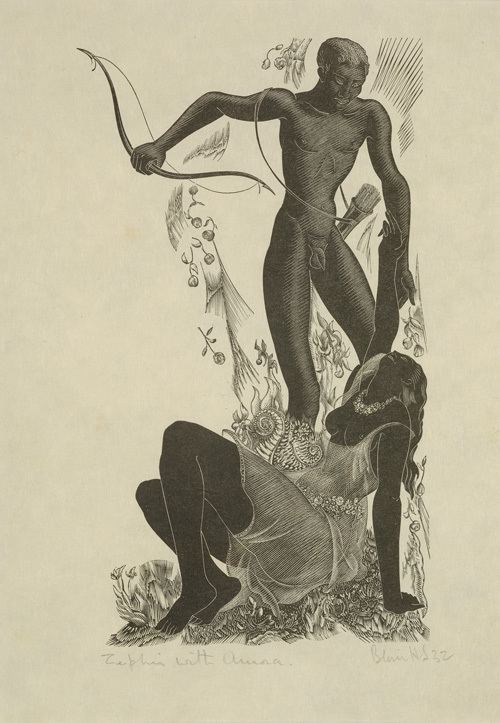
The early years

At the age of 13 Hughes-Stanton, unable to face the prospect of home life with his three sisters, joined the Royal Navy training ship HMS Coway. At the age of 19 he switched direction completely after a conversation with his father, the Royal Academician Sir Herbert Hughes-Stanton, and joined the Byam Shaw School of Art. There he came under the influence of Leon Underwood and, in 1921, he moved to Underwood's Brook Green School. In 1922 he joined the Royal Academy Schools, but Underwood remained the dominant influence on him. At Brook Green the American wood engraver Marion Mitchell introduced him to wood engraving, which set the direction of his life. Underwood and he were kindred spirits, to such an extent that, in 1925, Underwood left Hughes-Stanton in charge of the Brook Green School when he went to America.
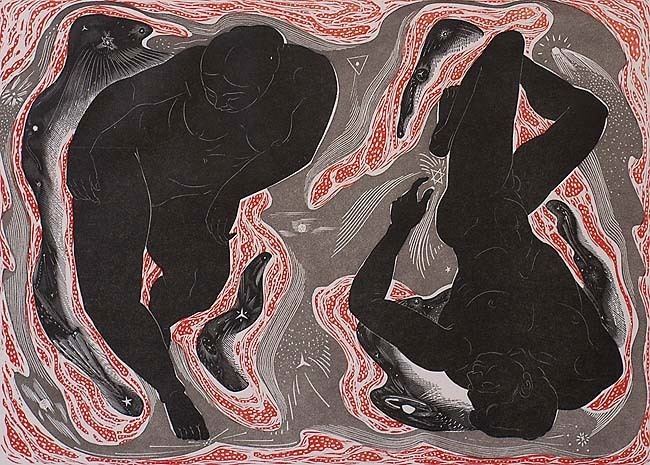
Hughes-Stanton met Eric Kennington, who introduced him to T. E. Lawrence. Hughes-Stanton was commissioned to engrave ten tail-pieces for the monumental limited edition of The Seven Pillars of Wisdom (1926). Some extra special copies had a full-page engraving by Hughes-Stanton for the dedicatory poem to "S.A.".
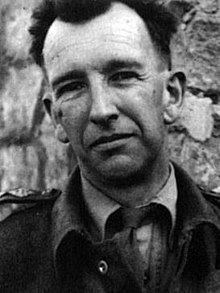
Other commissions followed and, in the next few years, he illustrated with wood engravings three tall folios for the Cresset Press — The Pilgrim's Progress (1928), The Apocrypha (1929) and D. H. Lawrence's Birds, Beasts and Flowers (1930).
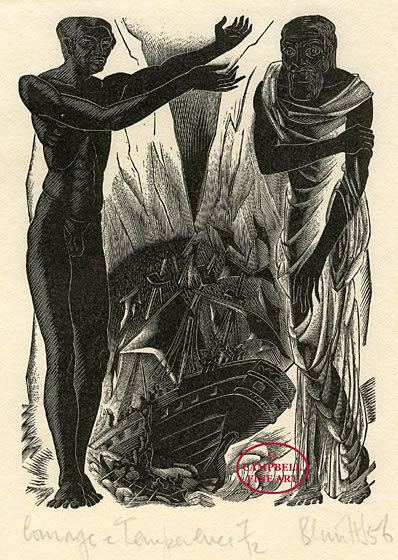
In 1925 he fell in love with Gertrude Hermes, a fellow student at Brook Green and another member of the Underwood inner circle. In 1926 he sold his copy of The Seven Pillars of Wisdom for £100 and married her. They had two children, Judith (born 1927) and Simon (born 1928).
The Gregynog Press and Gertrude Hermes
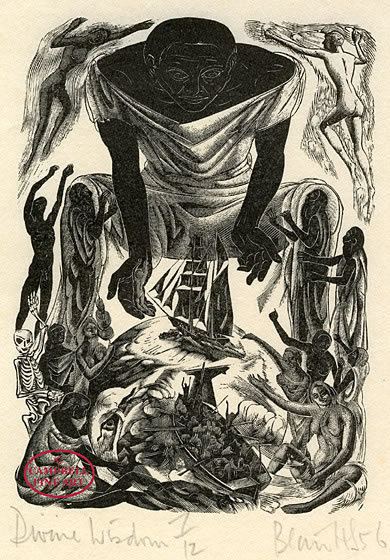
In 1930 Hughes-Stanton and Hermes, along with William McCance and Agnes Miller Parker, were appointed in various capacities to the artistic and business management of the Gregynog Press. Hughes-Stanton produced his characteristic wood engravings for Comus by John Milton in 1931, Erewhon by Samuel Butler in 1932 and The Revelation of Saint John the Divine, Four Poems by Milton and The Lamentations of Jeremiah, all of which appeared in 1933.

Relations were strained in a number of areas. Some of the board at Gregynog felt that Hughes-Stanton's wood engravings were too erotic, and his personal conduct was upsetting Margaret and Gwendoline Davies, who owned the press. In 1930 Hughes-Stanton had started an affair with Ida Graves, who offered him "Lawrentian sex". In March 1932 Hermes left Hughes-Stanton and moved back to London, where she stayed with Leon Underwood. Hughes-Stanton left the press in September 1933.
The Gemini Press and Ida Graves
When Hughes-Stanton left the Gregynog Press he returned to London with Ida Graves. Hermes had divorced him, and Graves's husband, Herbert Marks, had left her for Isobel Powys, removing their two children. Marks would not contemplate divorce, however, because of his social position, and gave Graves a weekly allowance of £4 a week provided that she took the blame for the separation. Hughes-Stanton and Graves had two children - Corin (born 1933) and Kristin (born 1935).
The couple moved to Higham near Colchester and founded the Gemini Press. Hughes-Stanton wrote in his first prospectus " I have founded the Gemini Press to be able, when occasion arises and unhampered by any outside prejudices, to make books in which there is a real fusion between contemporary writer and artist." In 1934 the press produced Epithalamion by Ida Graves, with 23 full-page wood engravings by Hughes-Stanton. The book is a celebration of their physical and spiritual wedding, even though they were unable to marry. Only half the edition was sold at the time of publication, partly because of the depression, but also a lack of business competence. In 1970 Hughes-Stanton offered the remaining 25 sets of Japan Vellum sheets and 125 sets of Basingwerk sheets to the Basilisk Press. In 1935 the press produced its second and final illustrated book Pastoral, or Virtue Requited by H.H.M. (Herbert Marks). They needed the money, but it must have been galling for the couple.
This period was a time of financial hardship for the couple, and commissions dried up completely at times. They moved to a late mediaeval timber house in Stratford Saint Mary, which they spent years restoring. By 1939 their relationship was almost at an end.
Hughes-Stanton produced a number of books, more or less significant, during this period. They include The Ship of Death by Lawrence (1933), Primeval Gods by Christopher Sandford (1934), Ecclesiastes and A Crime against Cania, both for the Golden Cockerel Press and both 1934, and Address by Abraham Lincoln at the Dedication of the National Cemetery at Gettysberg (1936), an unillustrated book printed by Hughes-Stanton at the Gemini Press in an edition of 50 copies, not for sale, the final publication of the press. In 1938, Hughes-Stanton won the International Prize for Engraving at the Venice Biennale.
The Second World War
At the start of the Second World War, Hughes-Stanton, like many other artists, undertook camouflage work before he enlisted in the British Army. In 1940 he joined the Royal Engineers. He served in the Middle East and then transferred to Greece, where he was captured. An over zealous prison guard in the temporary P.O.W. camp at Corinth shot him in the throat and skull when he strayed too close to the camp wire. His injury incapacitated him and he was moved to a series of camps in Germany, and he was finally repatriated to Britain in August 1943. Back in England he wrote to the War Artists' Advisory Committee, WAAC, in November 1943 seeking a painting commission. After a meeting with Kenneth Clark, the chairman of WAAC, he was given a commission to paint three pictures based on his experiences as a POW. After Blair-Stanton completed these, WAAC purchased two more pictures from him.
The later years and Anne Ross
Hughes-Stanton had already started teaching at the Westminster School of Art before the war, and he now became more and more reliant on teaching - at Colchester School of Art, Saint Martin's School of Art and the Central School of Art and Design. Even in his seventies he was teaching at Winchester School of Art. He had very few commissions during this period, and the engravings for his best-known book from this period - The Confessions of an English Opium Eater by Thomas de Quincey (Folio Society, 1948 and 1963) - were engraved in the early 1930s for the Fanfrolico Press. In 1955 he began to work with Lewis and Dorothey Allen of the Allen Press in California, and produced five books for them, mostly illustrated with linocuts.
Hughes-Stanton left Graves in 1950 and took refuge with Gertrude Hermes. In 1952 he married Anne Ross, a former student, with whom he had two daughters - Penelope (born 1954) and Chloë (born 1955).
He died in 1981, and his ashes were scattered on the River Stour, Suffolk by his two friends from the local pub, Peter and Joe.
There was an exhibition of his work at the Studio One Gallery in Oxford in 1982, and a memorial exhibition at the Minories Gallery, Colchester, in 1984.
His life and work
Although he did some work in oils and spent a great deal of time experimenting with linocuts in his later years, Hughes-Stanton's artistic production consists mostly of wood engravings. He is known for the very fine white lines of his engravings, which presented considerable difficulty to pressmen trying to print his engravings on hard handmade paper. The engravings are frequently of the female form, and contemporary judgements ranged from erotic to pornographic. Towards the end of his career his engravings featured semi-abstract figures. Examples of his fine cutting and individual style can be seen at the British Council website.
It is instructive to compare his career with that of his first wife, Gertrude Hermes. When they were married their careers showed equal promise. Clare Leighton wrote of him at the time "Of the same school is Blair Hughes Stanton (sic), equally brilliant, if not superior, in craftsmanship. ... (he) is paying the price of his brilliance by having many imitators." Hermes was elected a Royal Academician in 1971; Hughes-Stanton never received such an honour. Hermes had her retrospective exhibition at the Royal Academy; the retrospective at the Whitechapel Gallery for which Hughes-Stanton spent years collecting material never took place. Hermes' career moved ever upwards; that of her former husband moved from the creative brilliance of the Gregynog years to years of teaching into his 70s to make a living.
One must not, however, forget the brilliance of his early years and the influence that he had on wood engraving in the first half of the twentieth century.
Works illustrated include –
